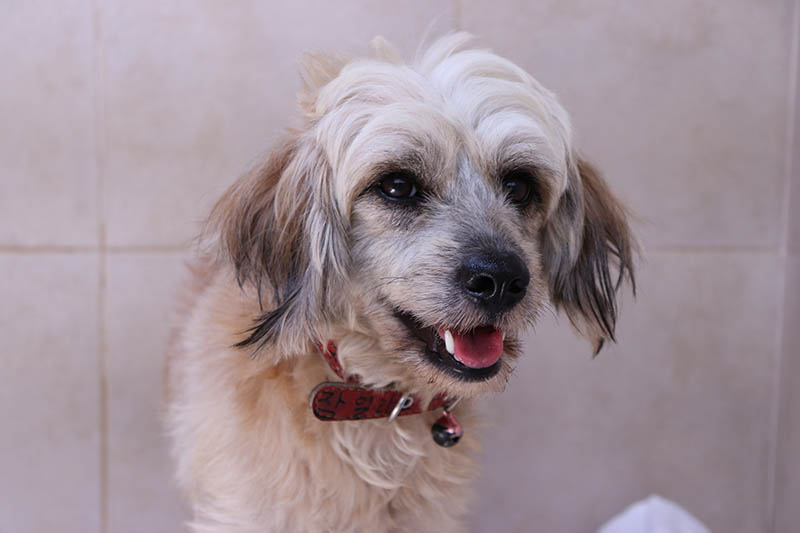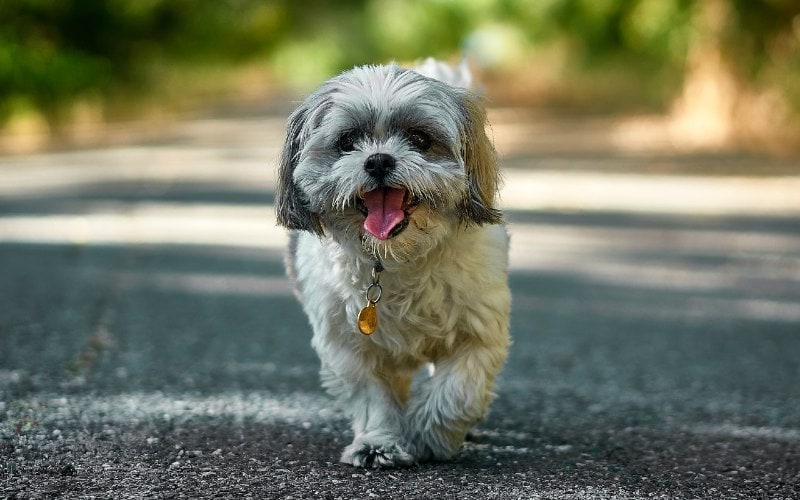Spanish vs Portuguese Water Dog: The Differences (With Pictures)

Updated on
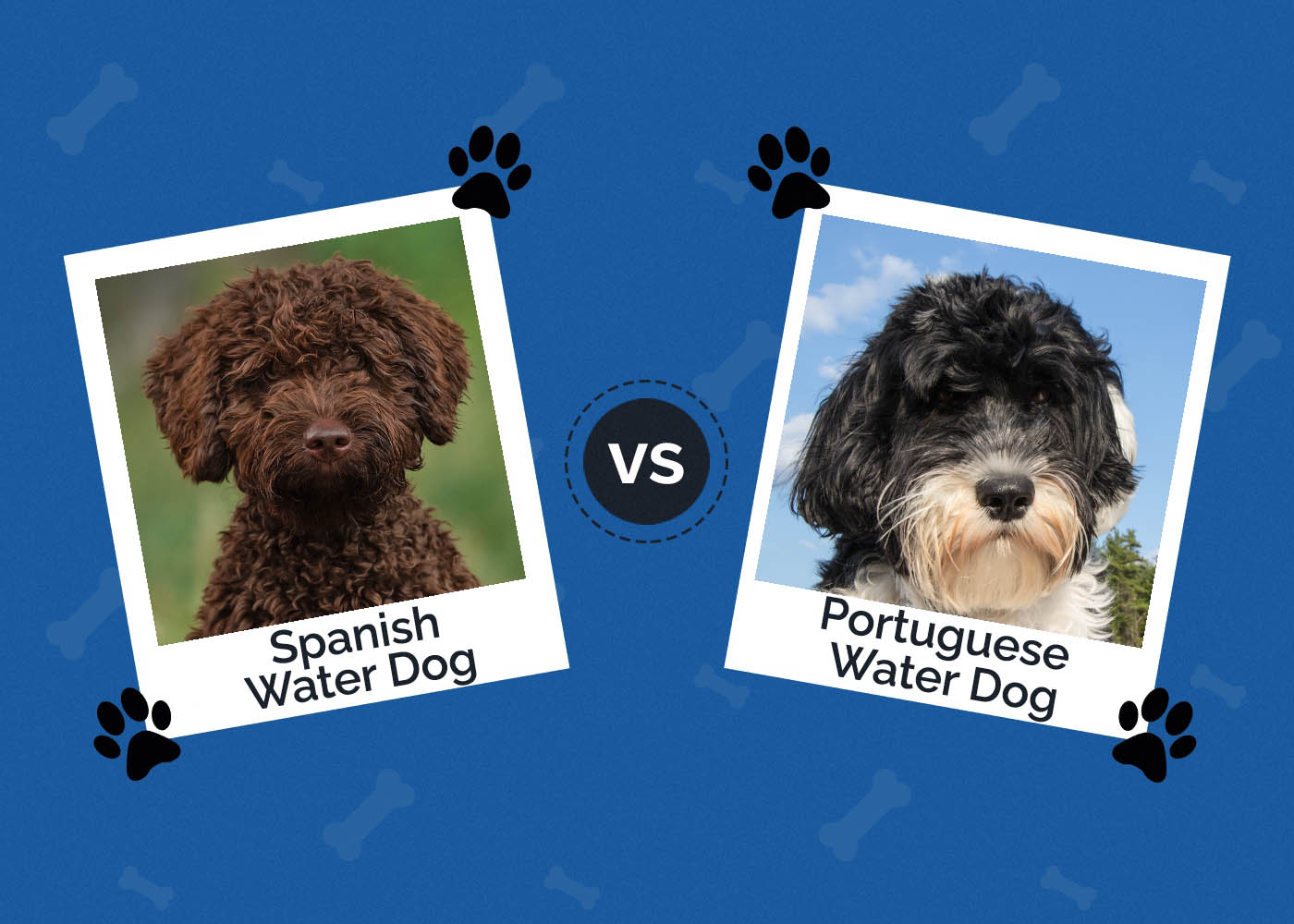
If you’re considering getting a water dog as your next furry companion, you may have come across two popular breeds: the Spanish Water Dog and the Portuguese Water Dog. Both breeds are known for their love of water, intelligence, adorable friendliness, and loyalty.
However, they do have some differences that may make one more suitable for you than the other. In this article, we’ll break down the similarities and differences between the Spanish Water Dog and the Portuguese Water Dog to help you make an informed decision on which one is right for you. Whether you’re an avid swimmer or just love a loyal and active companion, read on to find out which breed may be the perfect fit for your lifestyle.
Visual Differences

At a Glance
- Average height (adult): 15–17 inches
- Average weight (adult): 31–49 pounds
- Lifespan: 12–15 years
- Exercise: Around 60 minutes a day
- Grooming needs: Low, but specialized
- Family-friendly: Yes
- Other pet-friendly: yes
- Trainability: Easy
- Average height (adult): 17–23 inches
- Average weight (adult): 35–60 pounds
- Lifespan: 12–15 years
- Exercise: At least 40 minutes a day
- Grooming needs: High
- Family-friendly: Yes
- Other pet-friendly: Yes
- Trainability: Easy
 Spanish Water Dog Overview
Spanish Water Dog Overview
Spanish Water Dogs are known for their playful personalities and impressive smarts, making them a great addition to any family. However, due to their unique grooming needs and energetic nature, it’s crucial to understand how to properly care for and train these dogs. The Spanish Water Dog is a breed that has been around for centuries. They are believed to have originated in Spain, where they were used for herding, hunting, and guarding. Their waterproof coat made them ideal for working in wet and damp environments. They were also used for retrieving and fishing, as they were skilled swimmers.
The exact origin of the Spanish Water Dog is unclear, but it’s believed that they are descendants of the Barbet, a breed that was popular in France. The Spanish Water Dog was then developed in Spain by mixing the Barbet with local breeds such as the Poodle and the Portuguese Water Dog. Today, these dogs are actually still used for herding, hunting, and guarding, but they’re also popular as family pets.
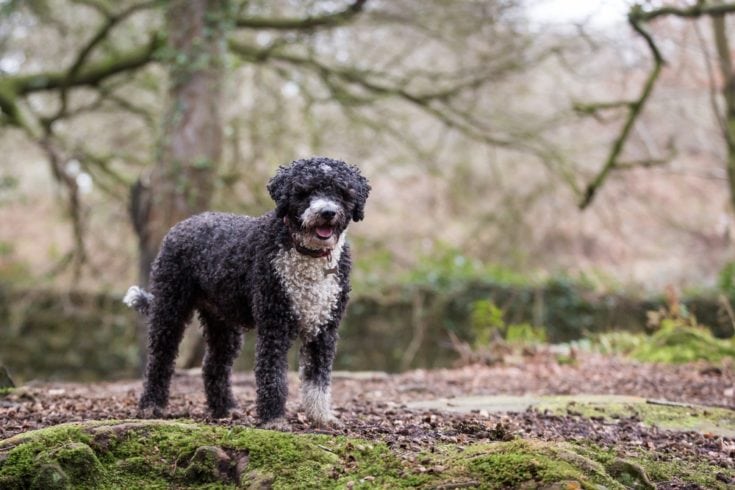
Breed Recognition
The American Kennel Club (AKC) recognized the breed in 2015, and it is classified as a herding breed. The United Kennel Club (UKC) recognized the breed in 1996, and it is classified as a gun dog. The breed is also recognized by the Fédération Cynologique Internationale (FCI), which is the world’s largest federation of national kennel clubs.
Physical Appearance
The Spanish Water Dog is a medium-sized dog breed that has a unique and distinct physical appearance. Their coat is one of the most notable features, as it is thick, curly, and wooly. The coat can range in color from black, white, and brown to various shades of gray. Unlike most breeds, the Spanish Water Dog does not shed, making it a hypoallergenic breed that is ideal for people with allergies.
The breed has a sturdy and muscular build, with well-proportioned legs that allow them to move with ease. They have a broad and deep chest, which gives them a powerful and athletic appearance. The ears are medium-sized and hang pretty close to the head, while the eyes are round and expressive, giving them a friendly and approachable look. The dog has a distinctive curly tail, which is usually docked to a third of its original length. This is done for practical reasons, as the breed was historically used for herding and hunting, and a long tail would have been a hindrance.
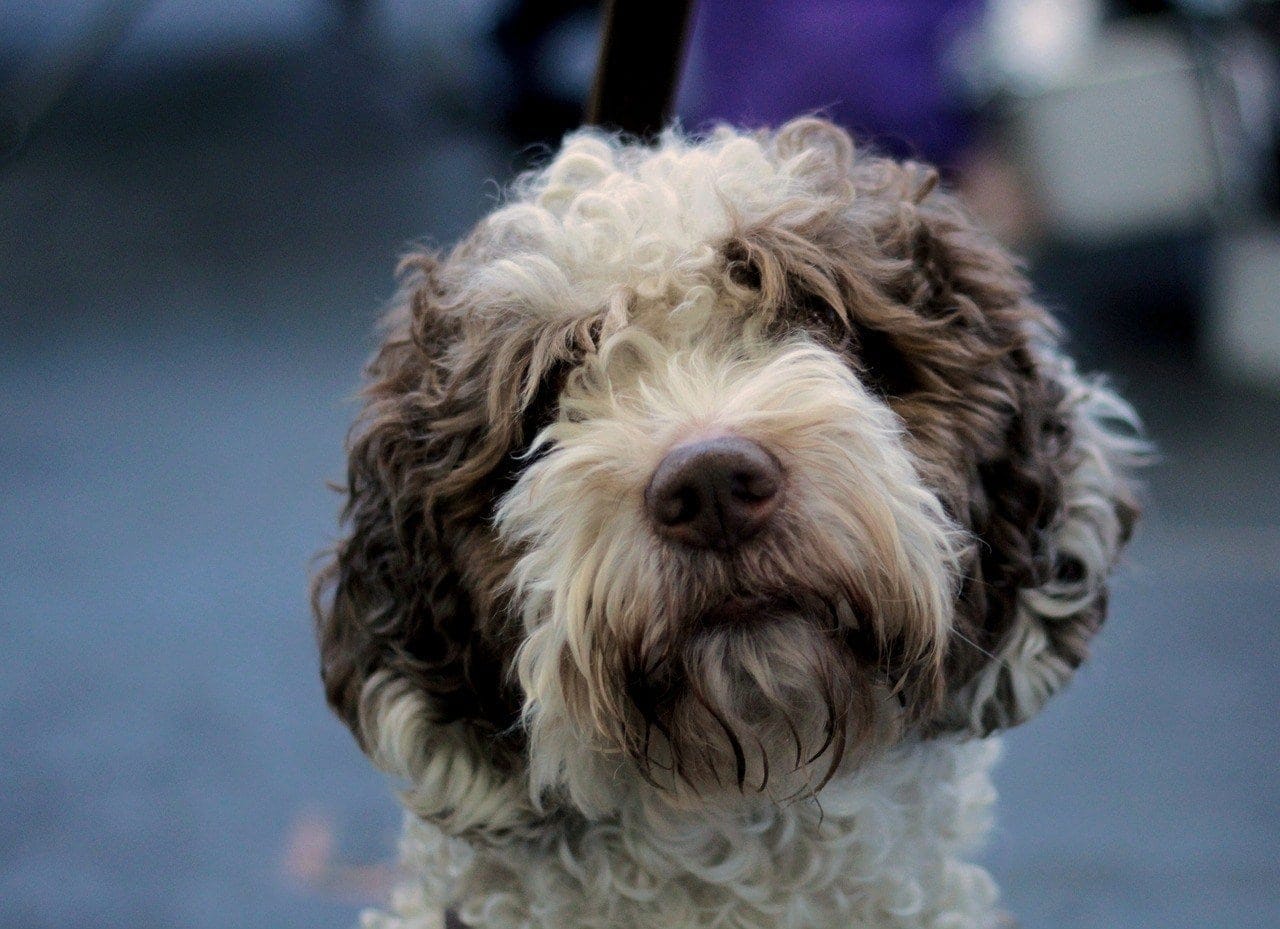
Personality
The Spanish Water Dog is a highly intelligent and energetic breed. They’re known for their happy and affectionate nature, and they love to be around people. They’re super loyal and protective of their family, but they can also be reserved around strangers. These pups are also highly trainable and enjoy learning new things. They excel in obedience training, agility, and other dog sports. However, they can be strong-willed and independent at times, so training them young is definitely helpful.
Training
Training these intelligent dogs can be a rewarding experience, but it requires patience, consistency, and positive reinforcement. They respond well to reward-based training methods, where good behavior is rewarded with treats, praise, and attention. You can train these adorable pups as young as 8–10 weeks of age.
Exercise
The Spanish Water Dog is a highly energetic breed that requires plenty of exercise and activity. These dogs are best suited to homes with large yards or access to open spaces where they can run and play. They enjoy things like long walks, hikes, and swimming, and they also excel in dog sports such as agility and obedience training. And it’s important to provide them with plenty of mental stimulation as well. Puzzle toys, interactive dog games, and obedience training can all help to keep them mentally stimulated and prevent boredom. Socialization is also important, especially during the puppy stage. Exposing them to different people, animals, and environments can help to prevent behavioral issues down the line.
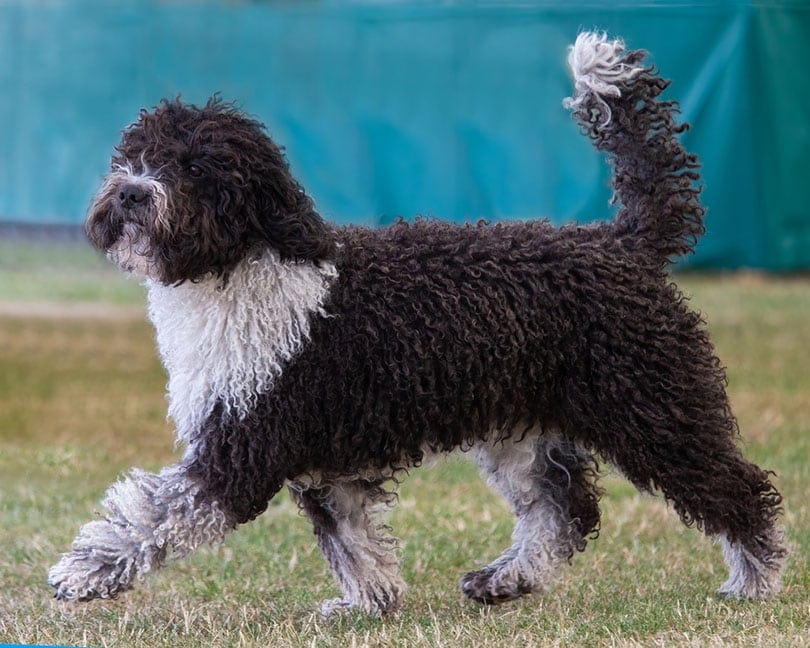
Common Health Issues
The Spanish Water Dog is a highly adaptable and active breed with a relatively good state of health. To prevent these health issues, regular visits to the veterinarian and proper grooming and care are essential. Some of the most common health problems in Spanish Water Dogs are:
- Hip dysplasia
- Eye problems
- Ear infections
Eye Problems
Another common health issue in Spanish Water Dogs is eye problems. These can include cataracts, progressive retinal atrophy, and glaucoma. Regular eye exams with a veterinarian can help detect these issues early on and prevent them from progressing. Additionally, feeding a diet rich in antioxidants can help support eye health.
Hip Dysplasia
Common to many canines (especially as they age), this is a genetic condition in animals (and humans) where the hip joint doesn’t develop correctly and fully and can lead to arthritis and pain. Although hip dysplasia can be present in puppies, it usually doesn’t show symptoms until the dog is older. It can be treated with surgery but can get worse with age.
Ear Infections
Spanish Water Dogs are also prone to ear infections due to their floppy ears and tendency to swim. That being stated, it’s essential to clean their ears regularly and keep them dry to prevent infections. It’s best to check their ears every few days to ensure they’re free of parasites, excessive wax/debris buildup, and infection. You may want to trim them as needed, as these dogs don’t require much grooming, but special attention should be paid to their ears.
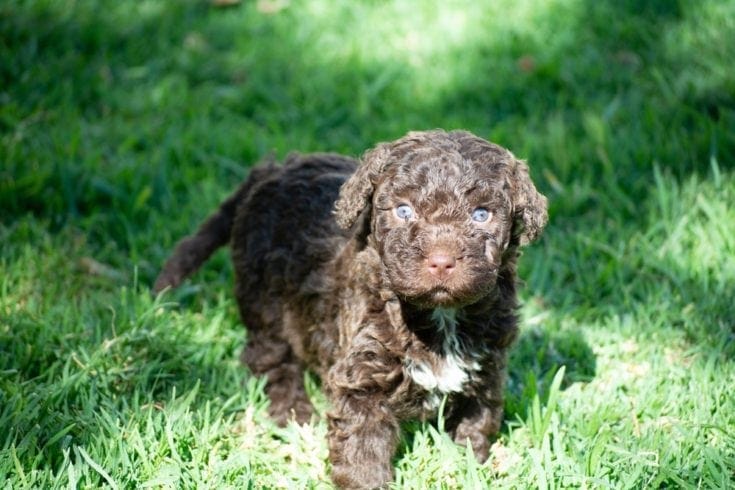
Puppy Cost
The cost of a Spanish Water Dog puppy can vary depending on several factors. Breeders who are registered with the American Kennel Club (AKC) typically charge between $1,500 to $3,000 for a puppy. However, some breeders may charge more or less, depending on the puppy’s lineage, health, and other factors.
It’s essential to note that the upfront cost of a puppy is just the beginning. Owning a dog comes with additional expenses, such as food, toys, grooming, and vet bills. The Spanish Water Dog requires irregular grooming, but it may be best that it’s done by a professional groomer because of the density of their thick wool-like coats. They don’t shed a lot, so dander isn’t an issue, but they can also be especially prone to parasite issues like fleas and ticks – especially if they’re outdoors a lot.
Suitable for:
Owners who enjoy outdoor activities such as hiking, running, or swimming. They also do well in homes with large yards or access to outdoor spaces where they can run and play.
Portuguese Water Dog Overview
Portuguese Water Dogs, also known as “Porties,” are a unique and intelligent breed that have become increasingly popular in recent years. From their hypoallergenic coats to their energetic nature, there’s so much to learn and love about these furry companions.
The Portuguese Water Dog has a long history that dates back to the 12th century. They were originally bred in Portugal to assist fishermen in their daily work. The dogs would swim alongside fishing boats, retrieve gear that fell overboard, and even carry messages between boats. They were highly valued for their intelligence, loyalty, and hardworking nature.
As fishing practices changed over time, the need for Portuguese Water Dogs declined. However, a small group of breed enthusiasts worked to preserve the breed, and in the 1930s, they were officially recognized by the Portuguese Kennel Club. In the 1970s, a Portuguese Water Dog named “Bo” was gifted to the Obamas, bringing the breed into the national spotlight and increasing their popularity in the United States.
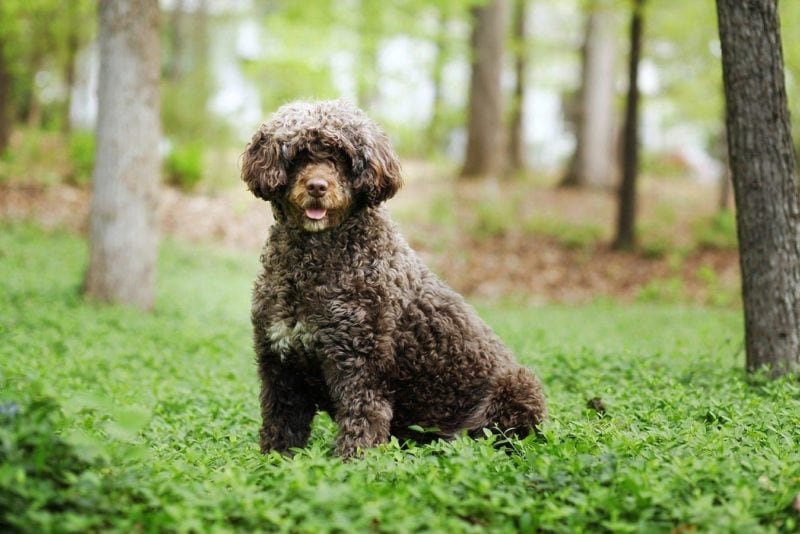
Breed Recognition
The Portuguese Water Dog is recognized by the American Kennel Club (AKC). They are classified as a member of the Working Group, which includes breeds that were originally bred for tasks such as guarding, herding, and pulling.
Physical Appearance
Portuguese Water Dogs have a distinctive appearance that sets them apart from other breeds. They’re a medium-sized dog, standing between 17 and 23 inches tall at the shoulder and weighing between 35 and 60 pounds. Their most recognizable feature is their coat, which is thick, curly, and hypoallergenic. This unique coat was originally developed to help protect the dogs from the cold waters of the Atlantic Ocean, where they were used as fishing companions. The coat comes in a variety of colors, including black, white, brown, and parti-colored.
In addition to their coat, Portuguese Water Dogs have several other physical characteristics that make them well-suited for their original purpose as fishing dogs. Interestingly, they also have webbed feet, which help them swim more efficiently, and a strong, muscular build that allows them to pull in fishing nets. They also have a distinctive, tapered tail that helps them maneuver in the water.
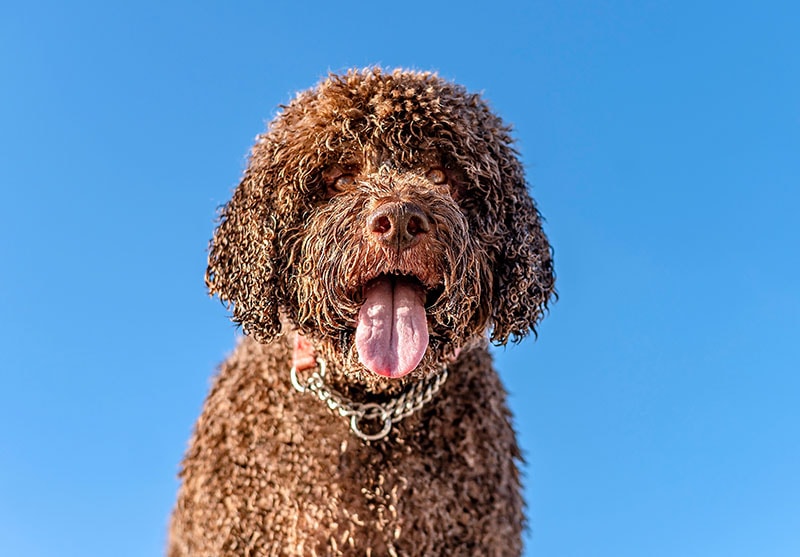
Personality
Portuguese Water Dogs are known for their friendly and playful personalities. They are loyal and devoted to their families, and love to be involved in all aspects of daily life. They are also super intelligent and trainable, making them well-suited for a variety of activities, including obedience, agility, and even therapy work.
However, it’s important to note that Portuguese Water Dogs can be strong-willed and independent. They require consistent, positive training from an early age to ensure that they develop good manners and behavior. They can also be prone to separation anxiety if left alone for long periods of time, so be sure to provide them with plenty of exercise, mental stimulation, and human interaction.
Training
As mentioned above, Portuguese Water Dogs are highly trainable and can begin basic obedience training as early as 8 weeks old. It’s important to use positive reinforcement methods, such as treats and praise, to encourage good behavior and build a strong bond with your dog. As your pup gets older, you can introduce more advanced training techniques, like agility, therapy, or hunting work.
Exercise
Portuguese Water Dogs need at least 40 minutes to 1 hour of exercise each day. They love to swim, but any form of exercise is beneficial. Without exercise, these dogs can get bored and somewhat destructive. Whether it’s a long walk, a trip to the dog park, or a game of fetch, these dogs will enjoy just getting out and spending time with you. Agility training can also help exercise your Portie.
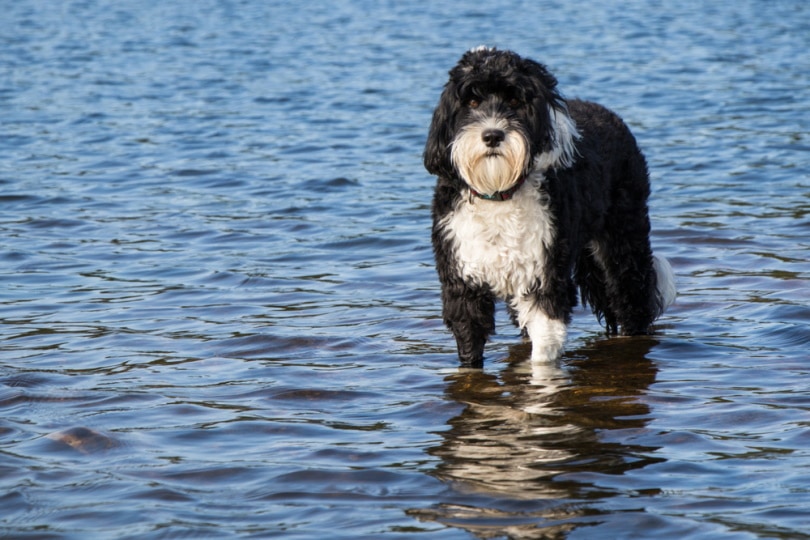
Common Health Issues
Though these happy pups are fairly healthy as a breed, they do have some issues that potential owners should be aware of. This includes:
- Progressive retinal atrophy
- Hip dysplasia
- Addison’s disease (the canine version)
Progressive Retinal Atrophy
Progressive retinal atrophy (PRA) is a genetic disease that affects the eyes of many dog breeds, including the Portuguese Water Dog. PRA is a degenerative condition that slowly causes the retinas to deteriorate, leading to vision loss and eventually blindness. Unfortunately, there is currently no cure for PRA, and affected dogs will gradually lose their vision over time.
While PRA is a hereditary condition, it is possible for a dog to be a carrier of the gene without showing any symptoms. Therefore, it’s important for breeders to test their breeding dogs for PRA to prevent passing on the gene to future generations.
Hip Dysplasia
As mentioned above, hip dysplasia affects the hip joints, which can lead to pain, mobility issues, and other complications. This occurs when the hip joint isn’t correctly aligned with the hip socket, causing inflammation and pain. Symptoms of this disorder include a hind leg bearing less weight, limping, and a decrease in their regular activities. This condition is most common in older dogs and ones that are overweight, though it can also affect young adult dogs too. Treatment for hip dysplasia may involve medications, physical therapy, or even surgery.
Canine Addison’s Disease
Addison’s disease is a disorder that affects the body’s ability to produce hormones. It occurs when the adrenal glands fail to create enough of the hormones aldosterone and cortisol. The adrenal glands are essential for controlling various aspects of your dog’s body, so your canine companion may show several signs. These may include vomiting, diarrhea, exhaustion, more frequent thirst and urination, and sometimes, trembling.
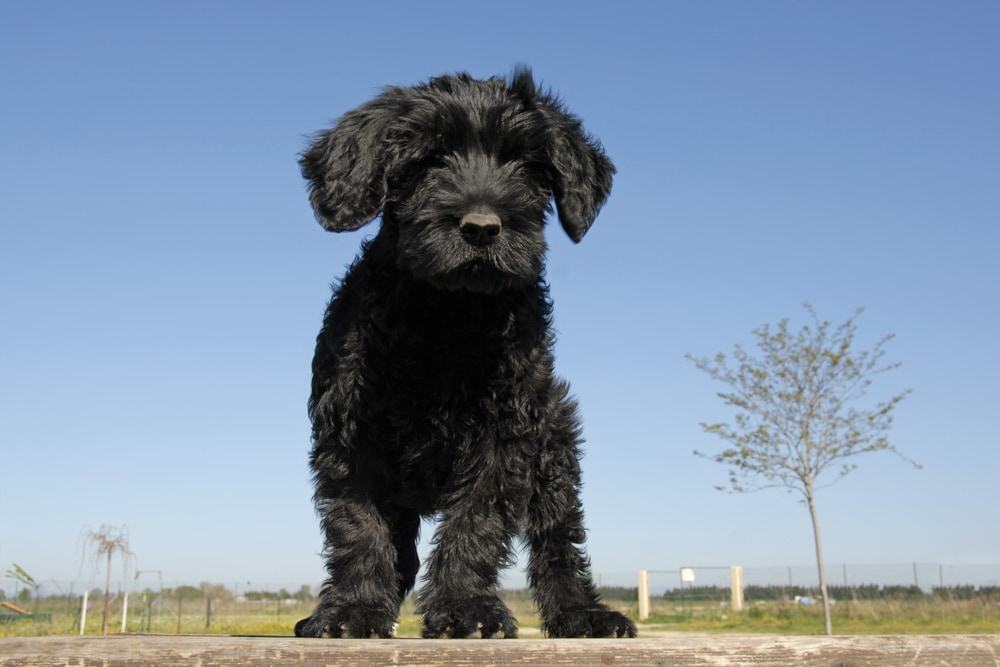
Puppy Cost
The cost of a Portuguese Water Dog puppy can vary depending on the breeder, location, and pedigree. On average, you can expect to pay between $2,000 and $3,500 for a purebred Portuguese Water Dog puppy. And don’t forget about the maintenance costs for these dogs – these costs can add up quickly, so it is essential to budget accordingly. Items such as slicker brushes, shampoo, initial vet visits/vaccines, and anti-parasite medicine should be all in your budget.
Suitable for: Best suited for active families who have plenty of time to devote to their dog’s exercise and training needs. They’re not well-suited for apartment living or families who are away from home for long periods of time. They are also best suited for families who are prepared to provide regular grooming and maintenance for their dog’s curly coat.
Which Breed Is Right for You?
Ultimately, the decision between these two breeds will depend on your lifestyle and preferences. Both breeds are great with children and make excellent family pets. If you are looking for a smaller, more active dog that is easy to train, the Spanish Water Dog might be the right choice for you. If you prefer a larger breed that is loyal and affectionate, the Portuguese Water Dog might be a better fit.
See also: Portuguese Water Dog vs. Goldendoodle: The Differences (With Pictures)
Featured Image Credit: (L) korolenok, Shutterstock | (R) Lynda McFaul, Shutterstock



